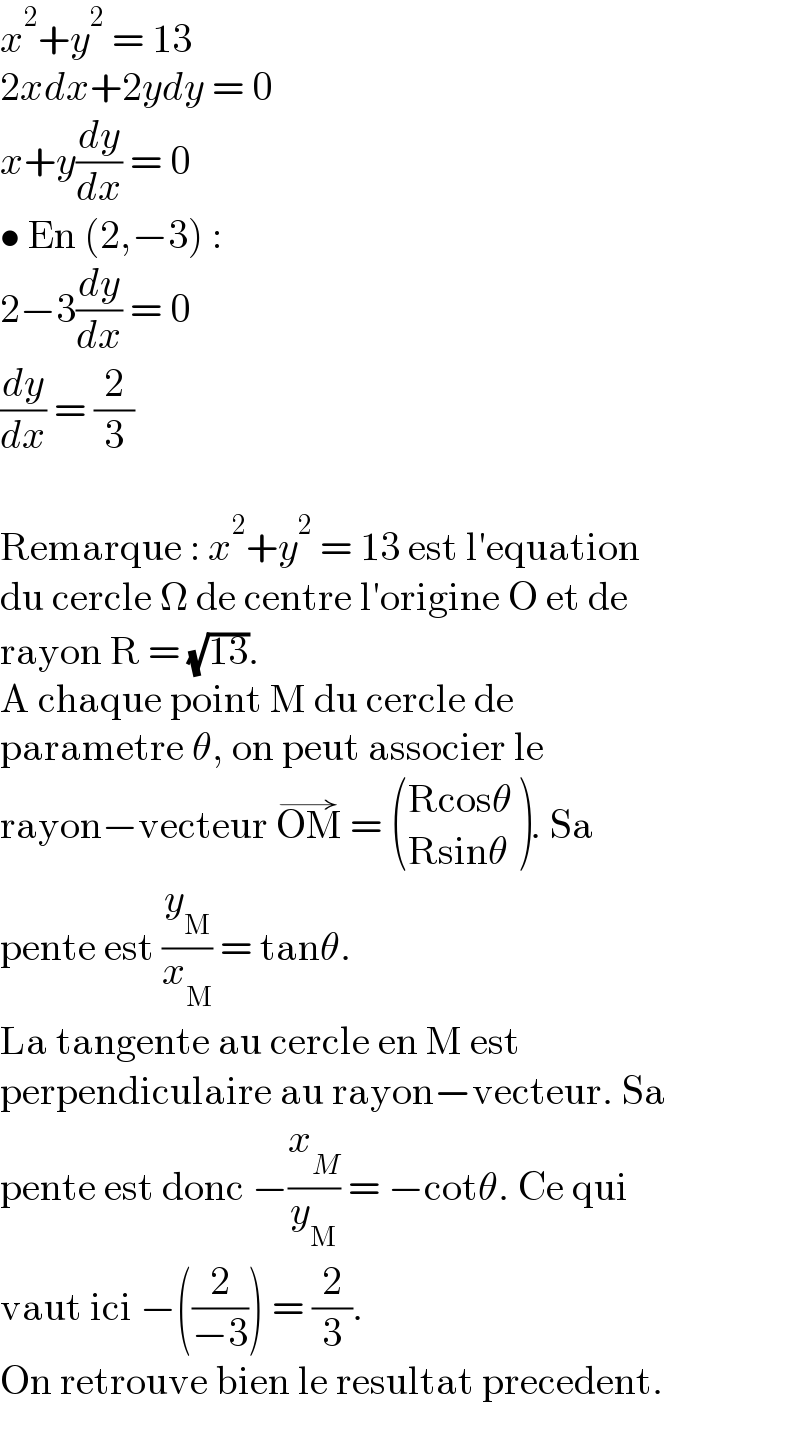Question Number 147905 by puissant last updated on 24/Jul/21

Answered by Olaf_Thorendsen last updated on 24/Jul/21

$${x}^{\mathrm{2}} +{y}^{\mathrm{2}} \:=\:\mathrm{13} \\ $$$$\mathrm{2}{xdx}+\mathrm{2}{ydy}\:=\:\mathrm{0} \\ $$$${x}+{y}\frac{{dy}}{{dx}}\:=\:\mathrm{0} \\ $$$$\bullet\:\mathrm{En}\:\left(\mathrm{2},−\mathrm{3}\right)\:: \\ $$$$\mathrm{2}−\mathrm{3}\frac{{dy}}{{dx}}\:=\:\mathrm{0} \\ $$$$\frac{{dy}}{{dx}}\:=\:\frac{\mathrm{2}}{\mathrm{3}} \\ $$$$ \\ $$$$\mathrm{Remarque}\::\:{x}^{\mathrm{2}} +{y}^{\mathrm{2}} \:=\:\mathrm{13}\:\mathrm{est}\:\mathrm{l}'\mathrm{equation} \\ $$$$\mathrm{du}\:\mathrm{cercle}\:\Omega\:\mathrm{de}\:\mathrm{centre}\:\mathrm{l}'\mathrm{origine}\:\mathrm{O}\:\mathrm{et}\:\mathrm{de} \\ $$$$\mathrm{rayon}\:\mathrm{R}\:=\:\sqrt{\mathrm{13}}. \\ $$$$\mathrm{A}\:\mathrm{chaque}\:\mathrm{point}\:\mathrm{M}\:\mathrm{du}\:\mathrm{cercle}\:\mathrm{de} \\ $$$$\mathrm{parametre}\:\theta,\:\mathrm{on}\:\mathrm{peut}\:\mathrm{associer}\:\mathrm{le} \\ $$$$\mathrm{rayon}−\mathrm{vecteur}\:\overset{\rightarrow} {\mathrm{OM}}\:=\:\begin{pmatrix}{\mathrm{Rcos}\theta}\\{\mathrm{Rsin}\theta}\end{pmatrix}.\:\mathrm{Sa} \\ $$$$\mathrm{pente}\:\mathrm{est}\:\frac{{y}_{\mathrm{M}} }{{x}_{\mathrm{M}} }\:=\:\mathrm{tan}\theta. \\ $$$$\mathrm{La}\:\mathrm{tangente}\:\mathrm{au}\:\mathrm{cercle}\:\mathrm{en}\:\mathrm{M}\:\mathrm{est} \\ $$$$\mathrm{perpendiculaire}\:\mathrm{au}\:\mathrm{rayon}−\mathrm{vecteur}.\:\mathrm{Sa} \\ $$$$\mathrm{pente}\:\mathrm{est}\:\mathrm{donc}\:−\frac{{x}_{{M}} }{{y}_{\mathrm{M}} }\:=\:−\mathrm{cot}\theta.\:\mathrm{Ce}\:\mathrm{qui} \\ $$$$\mathrm{vaut}\:\mathrm{ici}\:−\left(\frac{\mathrm{2}}{−\mathrm{3}}\right)\:=\:\frac{\mathrm{2}}{\mathrm{3}}. \\ $$$$\mathrm{On}\:\mathrm{retrouve}\:\mathrm{bien}\:\mathrm{le}\:\mathrm{resultat}\:\mathrm{precedent}. \\ $$
Commented by puissant last updated on 24/Jul/21

$$\mathrm{good}.. \\ $$
